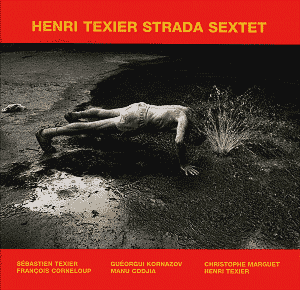1. Afrique à l’eau
2. O Africa
3. Blues d’eau
4. Flaque Nuage
5. O Elvin
6. Flaque Etoile
7. Reggae d’eau
8. Flaque Soleil
9. S.O.S. Mir
10. Flaque Lune
11. Sacrifice d’eau
12. Valse à l’eau
Sébastien Texier – Clarinet, alto clarinet,
alto sax
Francois Corneloup – Baritone sax
Guéorgui Kornazov – Tombone
Manu Codjia – Guitar
Christophe Marguet – Drums
Henri Texier – Double bass
Henri Texier established
himself as one of France’s outstanding bassists
through his deep, full-bodied tone, which
attracted such collaborators as Bud Powell,
Louis Sclavis, Joe Lovano, John Abercrombie,
Bob Brookmeyer and Lee Konitz. In recent years
he has become particularly interested in the
music of Africa and India, and the former
has clearly influenced this album, which is
also based around Texier’s ecological concerns
– namely "the politics of water".
This explains the many references to "l’eau"
in the tune titles (flaque
means "puddle"). The sleeve-note
explains that the album celebrates "the
miracle that is water" as well as expressing
outrage at the harm done by poisoning water
supplies.
This outrage is clearly voiced by the many
passages of virtually free blowing. In fact
the first track is a mixture of avant-garde
outbursts from the front line and a strong
African beat from the rhythm section. This
mixture continues in subsequent tracks. O
Africa starts with a strongly funky
melody which is interrupted by a swirling,
free-form sax solo and an equally anarchic
drum solo. Blues
d’eau is calmer – flowing easily
like a placid stream. Flaque
Nuage is a feature for the outspoken
trombone of Guéorgui Kornazov, while
I guess that O
Elvin refers to Elvin Jones, as
its gliding rhythm might be a tribute to that
drummer. Flaque
Etoile is a noisy bit of free improv
by the two reedmen.
Other influences from World Music besides
Africa are evident in tracks like Reggae
d’eau, which includes a bass solo
that allows us to savour Henri Texier’s rich
sound. For something completely different,
Sacrifice
d’eau is a discordant piece on
which the guitar growls angrily before the
whole band enters with what sounds like a
concerted dirge. As a contrast, the album
ends with the calm Valse
à l’eau, a romantic, sorrowful
piece.
This
is an album of contrasts – often demanding,
but it’s worth staying with, as repeated listenings
reveal new delights in the company of six
musicians who clearly have something to say.
Tony Augarde
